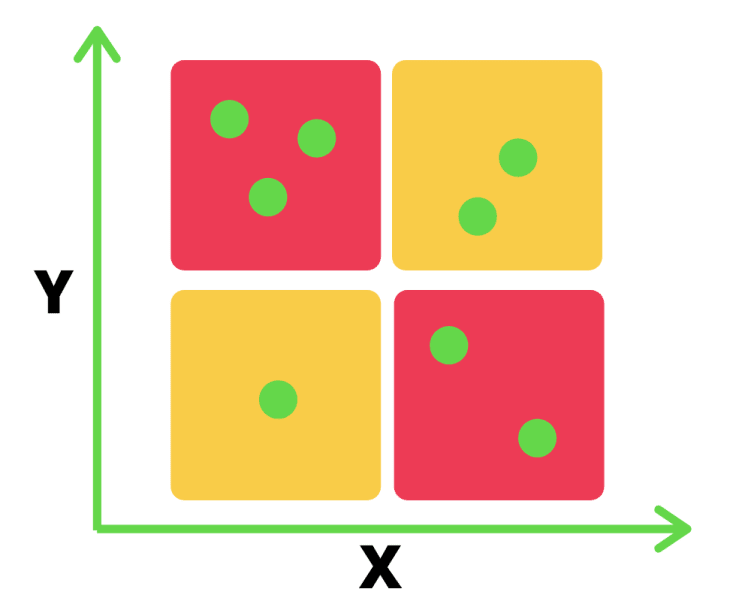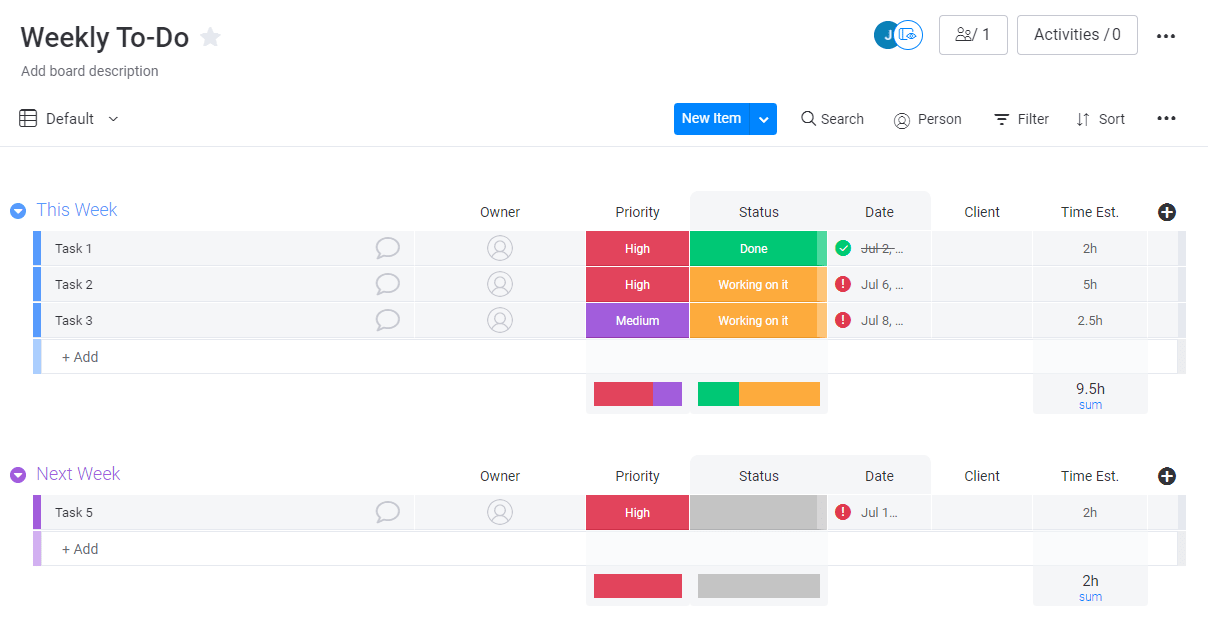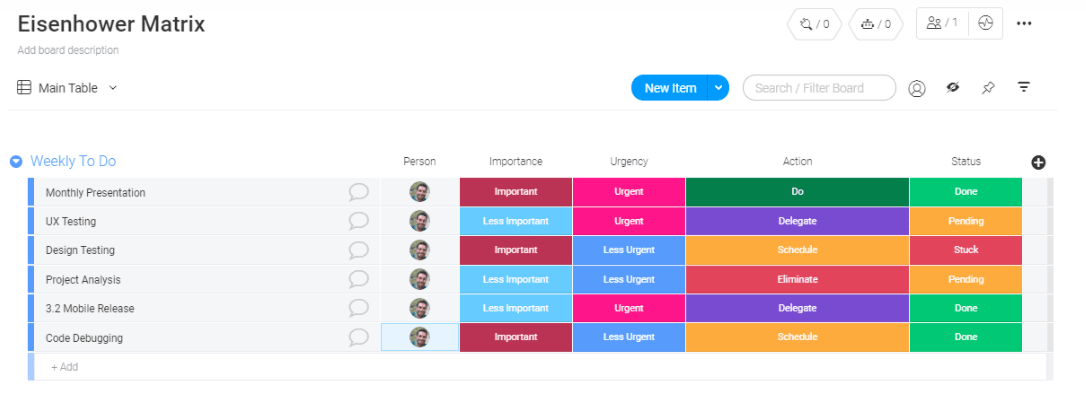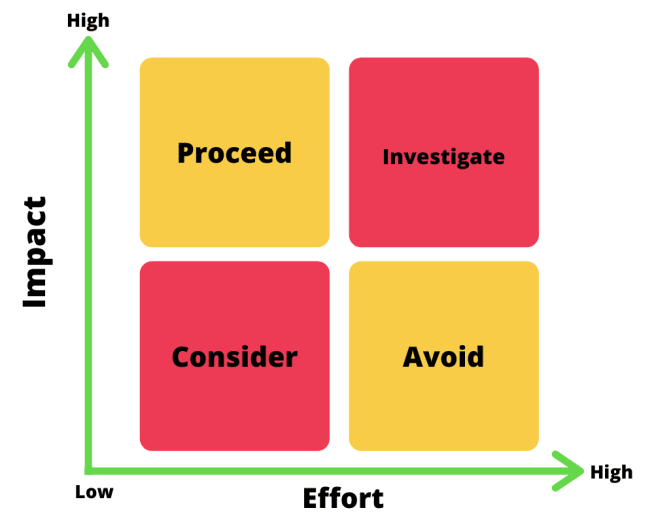Feeling overwhelmed by an endless to-do list? For project managers and teams, effective task prioritization isn’t just a nice-to-have—it’s essential for hitting deadlines, achieving goals, and avoiding burnout. A priority matrix, often known as the Eisenhower matrix, is a simple yet powerful framework for distinguishing urgent tasks from important ones, ensuring you focus your energy where it delivers the most impact.
This guide will walk you through what a priority matrix is, how to create one, and explore popular models like the Eisenhower and Action Priority matrix. More importantly, we’ll show you how to leverage these techniques within a dynamic work management platform like monday.com to transform your team’s productivity.
Ready to take control of your workload?
What is a priority matrix (and the Eisenhower matrix)?
A prioritization matrix is a 2-D visual tool that illustrates the relative importance of a group of items (like tasks, projects, or goals) based on two distinct criteria. It’s a powerful project management aid that helps you and your team focus on what truly matters, ensuring critical activities stay on track. One of the most popular and effective types of priority matrix is the Eisenhower Matrix, which we’ll explore further.
A typical prioritization matrix looks something like this:

Key components of a priority matrix
A priority matrix generally consists of four key components:
- Two axes (X and Y): These represent the criteria you’ll use to prioritize items (i.e. urgency and importance or impact and effort).
- Scale: This represents how you’ll measure your variables. Commonly, these matrices use a 2-point scale (I.e., urgent or non-urgent) but items could also be ranked on a scale, for example, from 1–5.
- Items: These are the projects, tasks, goals, or anything you want to plot into your matrix.
- Quadrants: You’ll weigh your items based on specific criteria and will plot them into one of the four quadrants in the matrix.
As you can see, it’s a pretty simple tool, but when used right, it can save you time, money, and increase project success.
Why using a priority chart will increase project efficiency and success
The Pareto Principle—often states as 80% of outcomes resulting from 20% of efforts—helps explain why many teams benefit from a priority matrix.
If you and your team don’t prioritize work and focus on what really matters, you could waste tons of time on tasks and activities that “don’t move the needle.”
A matrix can help you save time, resources, and keep team morale high by focusing on getting maximum results. Let’s take a look at how to create this tool.
How to create a priority matrix in 3 simple steps
Though anyone can make prioritization matrices, you won’t get the full value unless you use them as a team. After all, if different team members are ranking tasks in different ways, you could end up with conflicting priorities. That’s why we recommend the following 3-step approach:
Step 1: List your tasks and objectives
The first step is compiling the list of items for prioritization. If you already have a team to-do list or a product backlog, this will only take a few seconds — just pull up your list and make sure it’s up-to-date.
If you’re starting from scratch, pull the team together to create your task list. A weekly to-do list template like the one below can help you quickly jot down and track this info.

Step 2: Define your criteria (e.g., Urgency/Importance, Impact/Effort)
Now that you have a list of items, rank them based on the criteria and scale you chose. For instance, if one of your metrics is urgency, you and your team will decide whether each item is urgent or non-urgent. Other common criteria pairs include impact/effort or value/complexity.
Helpful hint: if you use a Work Management platform like monday.com, you can easily add custom columns for your criteria (e.g., ‘Urgency’, ‘Importance’) and set each task accordingly, so you have all the crucial information in one place.
Step 3: Plot your tasks and analyze the quadrants
Once you’ve prioritized and ranked your items, it’s time to plot them into your matrix. Map each task into one of the four quadrants based on its assessment against your chosen criteria. Don’t worry if you don’t completely get how to do this right now. We’ll cover it more in-depth as we explore specific matrix models.
Understanding the quadrants: from “do now” to “delegate”
Regardless of the specific criteria used, a 2×2 priority matrix will result in four quadrants, each suggesting a general approach to the tasks within it:
Quadrant 1: Urgent & important (Do first / Quick wins)
Tasks in this quadrant demand immediate attention and are critical for success. These are your top priorities. For an Impact/Effort matrix, these might be “Quick Wins.”
Quadrant 2: Important, not urgent (Schedule / Major projects)
These tasks are crucial for long-term goals but don’t require immediate action. They should be scheduled and planned for. In an Impact/Effort matrix, these could be “Major Projects.”
Quadrant 3: Urgent, not important (Delegate / Fill-ins)
Tasks here are time-sensitive but may not contribute significantly to your main objectives. If possible, delegate them. In an Impact/Effort matrix, these might be “Fill-ins.”
Quadrant 4: Not urgent, not important (Eliminate / Thankless tasks)
These tasks offer little value and are not time-sensitive. Consider eliminating them or deferring them indefinitely. In an Impact/Effort matrix, these are often “Thankless Tasks.”
Popular priority matrix models: Eisenhower vs. Action priority
A priority matrix is a flexible tool. You can prioritize items based on any criteria., but the easiest way to start is by implementing a proven format. Two of the most popular priority matrices are:
- The Eisenhower Priority Matrix
- The Action Priority Matrix
Though they’re similar in structure, each uses different criteria for prioritization. Below, we’ll go into an in-depth explanation for each.
The Eisenhower Matrix: Focusing on urgency and importance
The Eisenhower Priority Matrix is based on four time management quadrants developed by author Stephen Covey. According to the model, you can judge any task by two criteria: importance and urgency.
This results in four quadrants:

1. Upper left-hand side (important, not urgent – schedule): These tasks are highly important, but not as urgent. Though they don’t need immediate attention, delaying these too much will move them into the “urgent and important” quadrant. Examples include strategic planning, skill development, or preparing the project plan for a Q3 initiative.
2. Upper right-hand side (urgent and important, do first): This describes tasks that are highly important and extremely urgent, such as projects with tight deadlines or critical issues like a major system outage.
3. Bottom left-hand side (not urgent, not important – eliminate/delay): This quadrant is for tasks that are not important and not urgent. It’s worth examining whether these items take your team away from important assignments that better serve your bottom line. This could include time-wasting activities, unnecessary reports, or some social media browsing.
4. Bottom right-hand side (urgent, not important – delegate): These tasks are not super important to your core goals, but are urgent. These activities require immediate attention, but aren’t so crucial for your project’s success. Don’t ignore these tasks, however. If you do, they could snowball and turn into an unmanageable undertaking. Examples might include responding to some emails, scheduling some meetings, or handling minor interruptions.
If you’re in charge of a team, you may want to delegate these items to someone with more capacity, or automate them. With the right work project management platform like monday.com, you can automate emails or track how much time you spend assisting coworkers with non-related projects and pause on those efforts until you have time.
Here’s what the Eisenhower Priority Matrix can look like on a fully customizable work platform:

Action Priority Matrix – balancing impact and effort
This model is similar to the Eisenhower Matrix, but focuses on impact and effort. On the vertical side, we have a spectrum from low to high impact, and on the horizontal axis, low to high effort.
Here, you’ll list all your tasks and evaluate them based on their potential impact and the effort required to complete them.

Let’s break down each quadrant:
1. High-impact, low effort (Quick Wins): These are the items you want to tackle first. They highly impact your bottom line and are relatively simple compared to other items. In short, they’re quick wins, such as creating a call to action for your blog pieces or fixing a critical bug with a simple solution.
2. High impact, high effort (Major Projects): Typically, these important tasks require more resources. Planning your quarterly goals and developing a strategy for execution could belong in this quadrant , as could launching a new product feature.
3. Low impact, low effort (Fill-Ins): These are items that are easy to do but don’t provide a ton of value to your business goals, such as paying invoices or routine administrative tasks.
4. Low impact, high effort (Thankless Tasks): These items require some thought as to whether they’re worth the time and effort, such as over-optimizing a minor feature that few users access or spending excessive time on low-value reports.
Which model is right for you?
As the Eisenhower Priority Matrix focuses on importance and urgency, it’s more suitable for prioritizing work in the context of time. Use Eisenhower to prioritize:
- Daily tasks
- Decision-making
- Activities with deadlines
This matrix is great for tackling waterfall projects, tasks within a sprint, or managing your personal to-do list.
As we mentioned earlier, the Action Priority Matrix weighs items based on impact and effort. So this matrix might be ideal to prioritize opportunities such as:
- Business operations
- Product features
- Large initiatives
This matrix is best for prioritization when using an agile framework. It helps you narrow down which items should be in your next sprint and which to delay or scrap.
While Eisenhower and Action Priority are popular, other methods like MoSCoW prioritization or RICE scoring also offer valuable frameworks for different contexts.
Tips for maximizing your priority matrix effectiveness
- Be Objective: Strive for objectivity when assessing criteria like importance or impact. Avoid personal bias.
- Involve Your Team: For team projects, create and review the matrix collaboratively to ensure buy-in and shared understanding.
- Regularly Review and Adjust: Priorities change. Revisit your matrix regularly (daily, weekly, or per project phase) to ensure it remains relevant.
- Don’t Overpopulate “Do First”: If too many tasks land in the “Urgent & Important” or “Quick Wins” quadrant, it might be a sign of unrealistic planning or a need to break down tasks further.
- Use Clear Criteria: Ensure everyone understands what “urgent,” “important,” “high impact,” or “high effort” mean in your specific context.
- Integrate with Your Workflow: Use your priority matrix to actively guide your daily and weekly planning. A Work Management platform like monday.com can help operationalize this.
Common pitfalls when using a priority matrix (and how to avoid them)
- Misjudging Urgency vs. Importance: It’s easy to confuse tasks that are merely loud (urgent) with those that are truly impactful (important). Avoidance: Clearly define what “urgent” and “important” mean for your team/project before plotting.
- Too Many “Do First” Items: If everything is a top priority, then nothing is. Avoidance: Be ruthless in your assessment. If your “Urgent & Important” quadrant is overflowing, re-evaluate or break tasks down further.
- Failing to Delegate Effectively: Not delegating tasks in the “Urgent, Not Important” quadrant can lead to burnout on low-value activities. Avoidance: Empower your team and trust them with delegated tasks. Ensure they have the resources and authority needed.
- Not Reviewing or Adjusting: A priority matrix is not a static document. Priorities shift as circumstances change. Avoidance: Schedule regular reviews of your matrix to ensure it still reflects the current reality and goals.
- Lack of Team Alignment: If team members have different interpretations of the criteria or priorities, the matrix loses its effectiveness. Avoidance: Develop the matrix collaboratively and ensure everyone understands and agrees on the prioritization.
How monday.com supercharges your priority matrix implementation
While understanding priority matrices is key, implementing them effectively, especially for teams, requires the right tools. monday.com’s Work Management platform provides a dynamic and collaborative environment to bring your priority matrices to life. Here’s how:
Visualizing priorities with customizable boards and views
On monday.com, you can create highly customizable boards where columns directly represent your chosen matrix criteria (e.g., Status columns for ‘Urgency’ and ‘Importance’, or ‘Impact’ and ‘Effort’). This allows you to visually map out tasks. Then, leverage different board views like Kanban, Chart, or Table to see your priorities from various angles, making it easy to identify what needs attention.
Automating task assignments based on matrix quadrants
Streamline your workflow with powerful automations. For example, set up rules like: “When a task is marked ‘Urgent’ AND ‘Important’, automatically assign it to the team lead and set a due date for today.” This reduces manual work and ensures prompt action on critical items.
Collaborating effectively on prioritized tasks
monday.com keeps everyone on the same page. Discuss priorities directly within task items, share files, @mention teammates, and get real-time updates. This transparency ensures alignment even as priorities shift.
Tracking progress with real-time dashboards
Gain a high-level overview with customizable project dashboards. Visualize how many tasks fall into each quadrant, track progress on high-priority items, and monitor team workload to ensure balanced distribution and timely completion.
monday.com features & templates for priority matrices
- Task management: Set task dependencies, assign team members tasks within the matrix, and monitor progress for all of your projects.
- Automation: Automate your tedious processes—such as notifying team members when a status changes— so you can focus on what really matters.
- Collaboration: Add tags, share files, and transparently communicate with team members on the platform so everyone has the same view of what’s happening, even as priorities shift.
Thanks to flexible building blocks, you can create any workflow you need from scratch, or get started immediately with one of our 200+ templates. Specifically for prioritization, you can use or adapt:
- Resource Allocation Template
- Contingency plan template
- Project milestones template
- Eisenhower Matrix Template
- And more!
Get the full list of all of our templates here.
Start Prioritizing Smarter with monday.com
Effective prioritization is the cornerstone of productivity and project success. A priority matrix, whether it’s the Eisenhower, Action Priority, or a custom model, provides a clear framework to identify what truly deserves your team’s focus.
Ready to transform your task management and achieve peak productivity? Start building your dynamic priority matrix with monday.com today and experience the power of clear, collaborative prioritization. Explore monday.com features or Get started for free.
